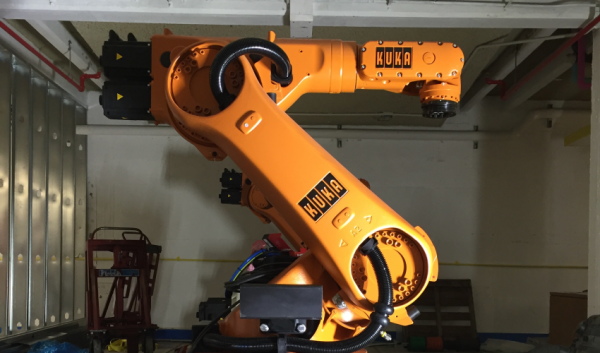Maker Culture & New Digital Technologies

With the broad support of the Provost and the President, the School of Architecture has embarked on a major initiative to integrate cutting-edge technologies into its teaching and research practices. This initiative is closely aligned with the maker movement that is developing on campus and in higher education, using maker culture to address some of the most pressing issues about the evolution of higher education in the emerging information age. Our leadership in this area was recently featured in an episode of Game Changers.
One area of investment has been in robotics. The school has recently acquired two Kuka KR60 robotic arms, installed them with access to a shared work positioner, and hired Benjamin Rice as a full-time research scientist to incubate and support the integration and evolution of the technology. This setup allows for research and development in architectural robotics to establish itself and engage with teaching and research on a rapidly accelerated timeline. The robots are already operational and their potential is actively being explored and developed in some early unfunded research projects, like the highlighted video of robotic drawings.
CNC and 3D printing technologies are also critical to our capacity to integrate cutting-edge technologies, workflows, and practices into our teaching and research. Our labs currently feature Fusion Deposition Modelling (FDM) and Selective Layer Lamination (SLL) 3D printing technologies which allow for strong and complex plastic part production, inexpensive form and massing conceptual model production, and full color 3D models. Similarly, our CNC capabilities currently include 3-axis milling, lathe milling, wire bending, and oscillating knife cutting. This palette of CNC tools allows for a wide variety of production options in both material and scale.
Another area of investment is aerial photogrammetry, virtual reality, rendering, and advanced visualization. We have been leading the University in establishing protocols for aerial photogrammetry that comply with FAA's guidelines for commercial drone operations. Similarly, we have been working with the Texas Advanced Computing Center (TACC) and commercial partners like VIMtrek to evaluate cutting-edge technologies for visualizing architecture and planning design work in two, three, and four dimensions. These technologies have the potential to radically shift the type and quality of data that designers begin with, as well as how their designs can be evaluated and experienced during an iterative design process.
The School of Architecture is committed to applying the most relevant and promising emerging technologies to address the host of critical social, economic, and ecological issues that face the next generation of designers and planners.

